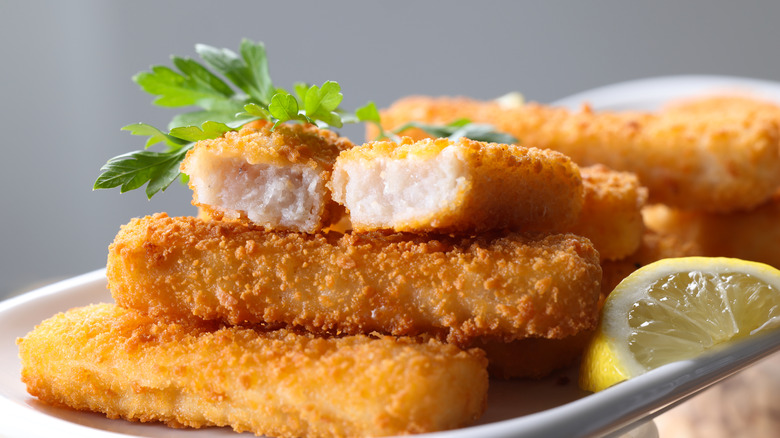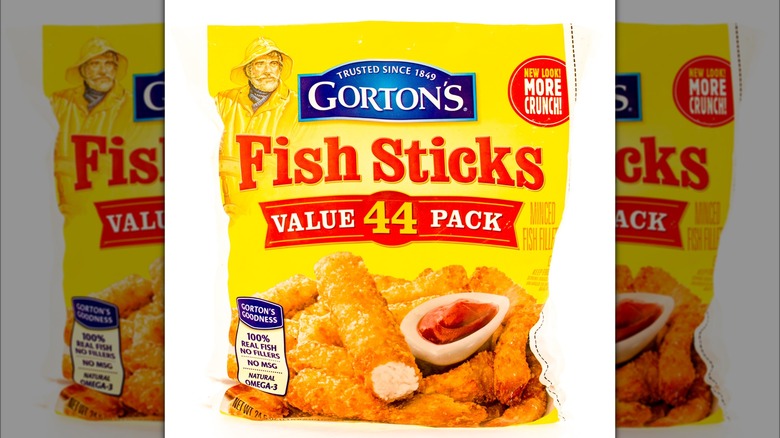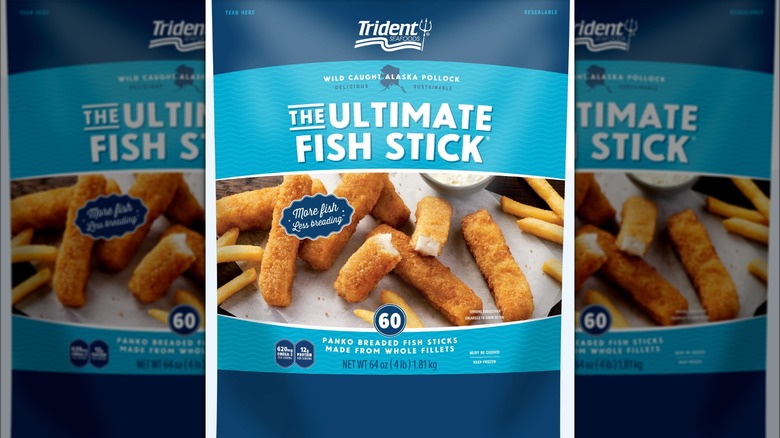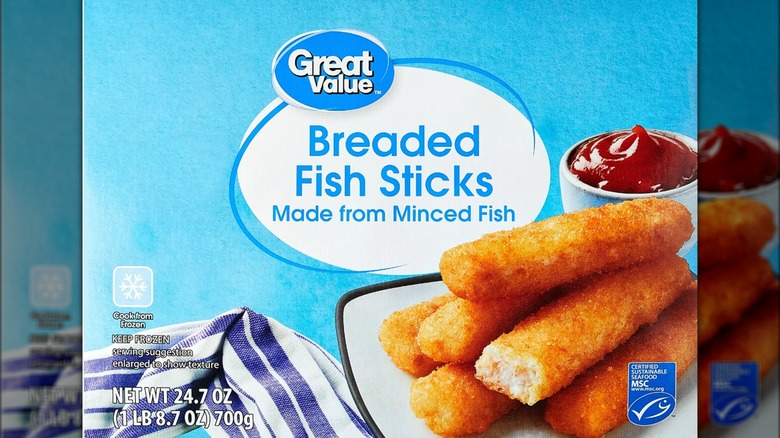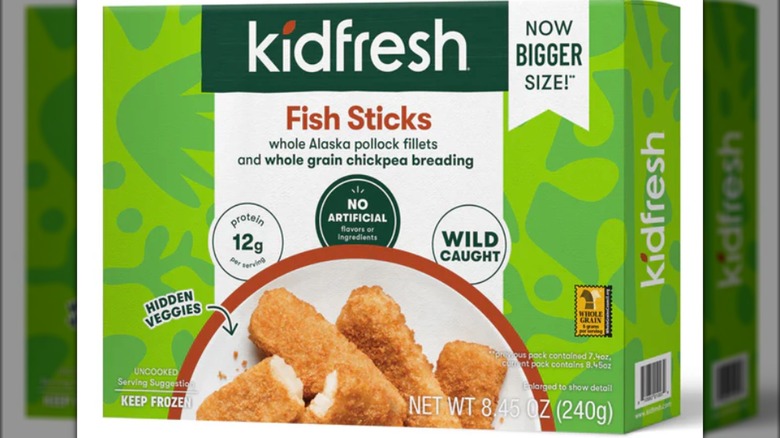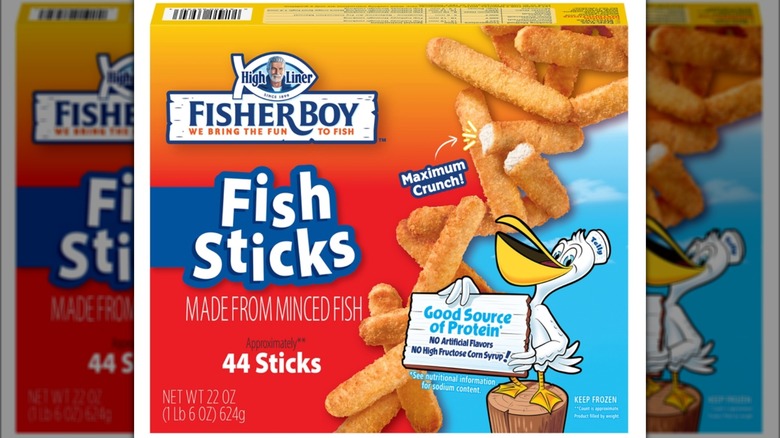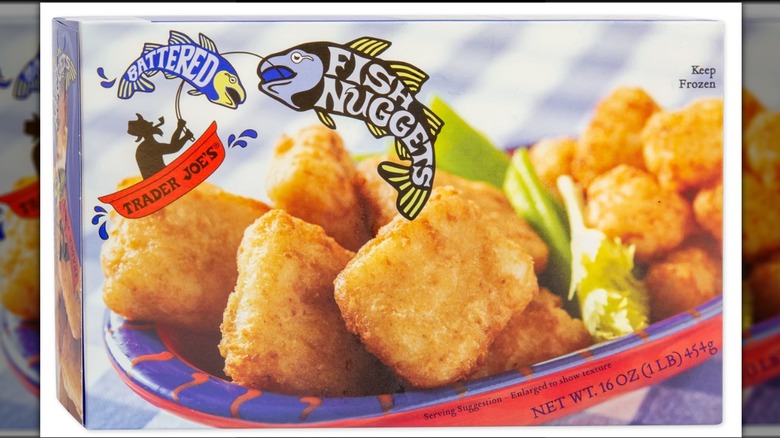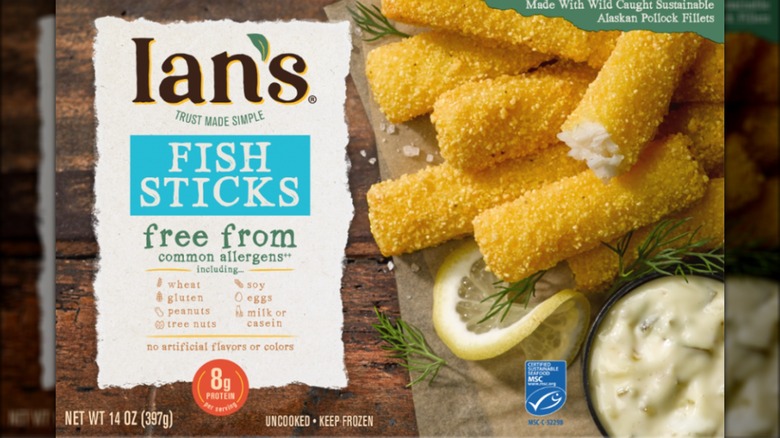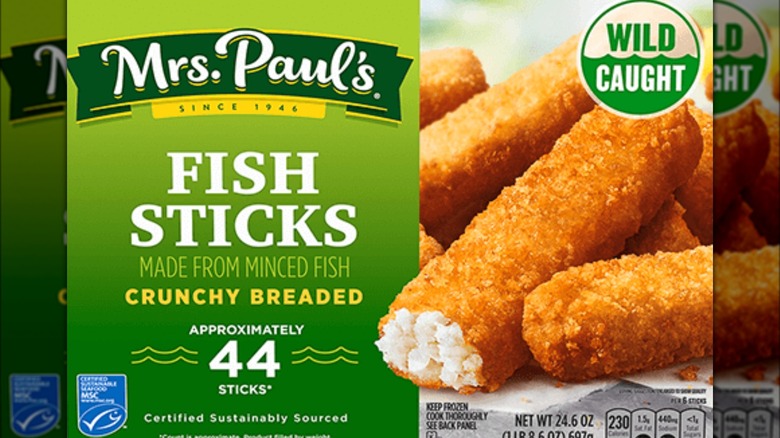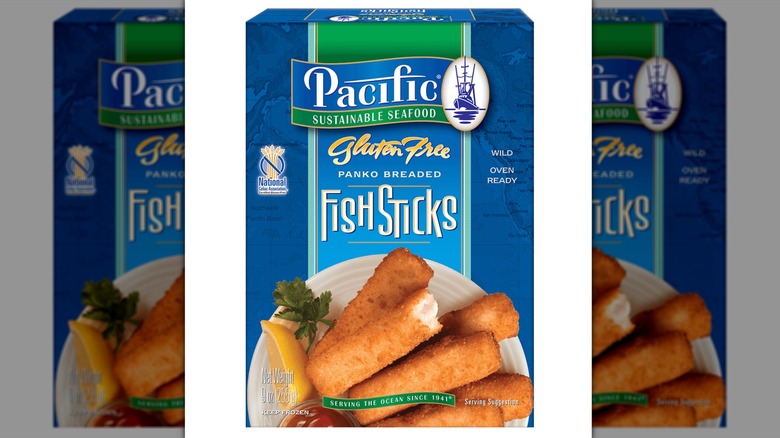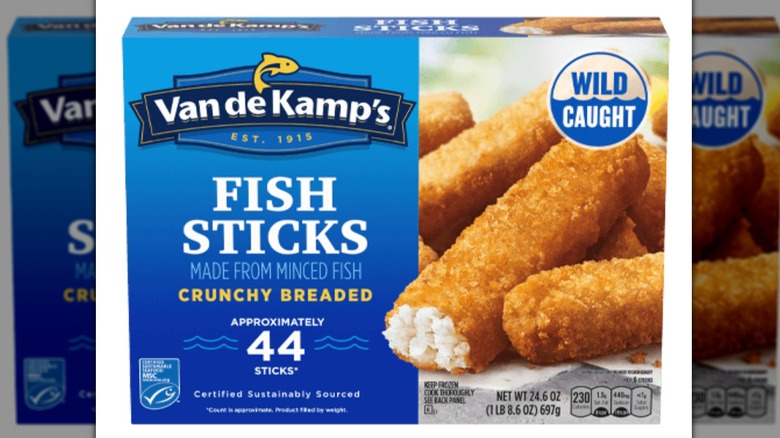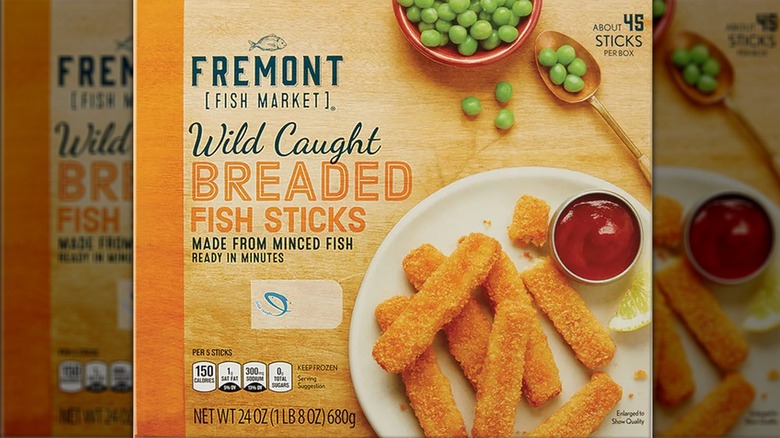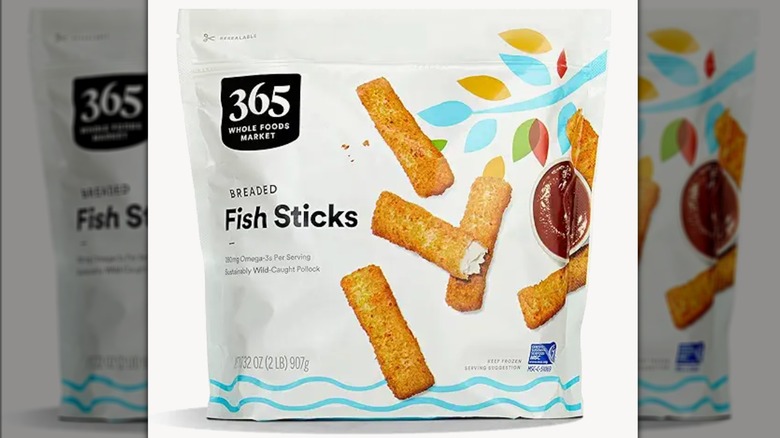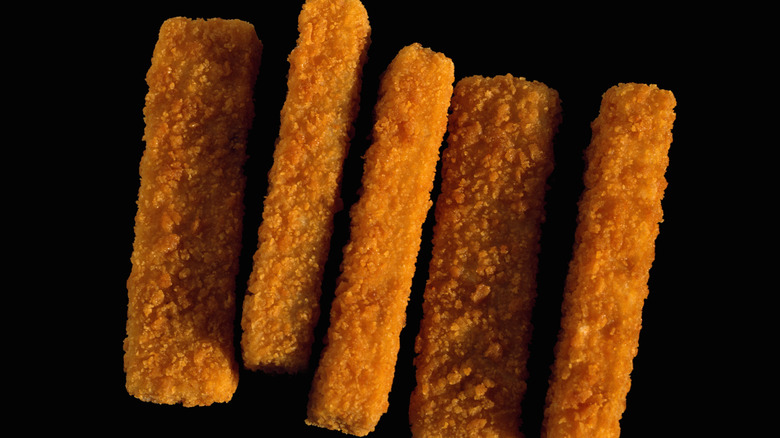The Healthiest And Unhealthiest Store-Bought Fish Sticks
We may receive a commission on purchases made from links.
Fish sticks are a great, versatile item to have stocked in your freezer. Whether you want to make fish stick tacos, dip them into your favorite sauce, or put them on your sandwich, they can be a delicious meal. But, like most fried foods, fish sticks aren't necessarily healthy. They tend to be high in fat (mostly because of oil used to fry them), high in sodium, and have additives or unnecessary ingredients.
We explored many different brands of fish sticks, and have come up with ones that are a little bit healthier. As a certified nutrition coach, I was able to decipher which fish sticks aren't nearly as bad for you. After all, while "unhealthy" foods can have a place in a well balanced diet, there are ways to make the best choice when indulging in fried foods.
One main thing we focus on is the amount of fat in fish sticks, especially compared to the protein count. Though fat is necessary in a diet, having too much — especially from oils that have saturated fats – can cause many health issues. Protein, however, is needed in the body and has great health benefits. With that information, plus paying attention to ingredient lists and sourcing of the fish, we created our ranking of healthy and unhealthy fish sticks.
Unhealthiest: Gorton's Cod Fish Sticks
Gorton's brand specializes in seafood, and has been around since 1849. It sells frozen seafood that is either grilled or breaded and fried. As a sustainable consumer, you may also appreciate that Gorton's sources its fish responsibly, works on its carbon footprint reduction, and uses eco-friendly packaging. But although it's a great, respectable company — we hate to tell you that Gorton's Cod Fish Sticks aren't that healthy.
For every three fish sticks(or 85 grams), there are 200 calories, 10 grams of fat, and 8 grams of protein. A little fun fact: for every gram of fat there are 9 calories, but for every gram of carbohydrates and protein, there are 4 calories. If you see a food with more fat than protein or carbohydrates, that's a little indicator that most of the calories are coming from fat.
Now, don't get us wrong, fat is important to have in a balanced diet. However, having too much fat can lead to cardiovascular diseases, obesity, and heart disease. Speaking of heart health,- there are also 390 milligrams of sodium in Gorton's fish sticks, which is 17% of the daily recommended allowance from the FDA. The higher fat content matched with the sodium is a recipe for a not-so-happy heart.
Healthiest: Trident The Ultimate Fish Stick
Trident is another company that focuses solely on seafood. It has been around for over 50 years, and all of its fish comes straight from Alaska. Trident also commits to sustainable practices like only partnering with responsibly managed fisheries and conducting business ethically. Happily, we can add Trident's Ultimate Fish Sticks to our list of healthier options.
Three Trident fish sticks contain about 170 calories. For the macronutrients, there are 8 grams of fat, 14 grams of carbohydrates, and 12 grams of protein. With more grams of protein than fat, and the protein count being close to the carbohydrate count, we can confidently say that these fish sticks are a great protein source overall.
If you are an active person and are trying to gain strength or lose weight, many nutritionists recommend aiming to eat close to your body weight in grams of protein. Knowing this, getting 12 grams of protein in just three fish sticks is great! What wouldn't be great is allowing more fat into your diet just to get the protein count up. With these fish sticks, you are still getting some fat, but at least it isn't more than the protein.
Unhealthiest: Great Value Breaded Fish Sticks
Great Value is Walmart's brand, and it carries everything from milk to vegetables to household essentials. Plus, of course, its own version of fish sticks. The fish itself is minced Alaska pollock — however, the ingredient list is quite long, including other items that you may not be familiar with.
The serving size for these fish sticks is seven sticks, which is about 111 grams. Although this serving size is slightly larger than other brands, we can actually commend Great Value for being realistic with the serving size. Who is just eating three fish sticks, anyway? In this serving, there are 260 calories, 12 grams of fat, 27 grams of carbohydrates, and 10 grams of protein.
Unfortunately, we can't say that these macronutrients are very balanced. The fat and carbohydrate counts are way higher than protein, making these fish sticks a bad protein source. For 260 calories, 10 grams of protein is not a significant amount. There is also a whopping 530 milligrams of sodium in the fish sticks — 23% of the FDA's recommended daily intake. Overall, the Great Value fish sticks are more of a junk food than an ingredient to incorporate into a healthy meal. The high levels of fat, sodium, and lower level of protein bring it straight to our unhealthy list.
Healthiest: Kidfresh Fish Sticks
Kidfresh is a brand that strives to make kid-friendly meals. It was created by parents who wanted healthy and tasty meals that are easy to prepare for their children. From pasta, to waffles, to chicken nuggets, this brand sells many kid-friendly options. Kidfresh uses as little processing as possible, no artificial ingredients, and packs the meals with vitamins and minerals that kids need to grow strong. Kidfresh also works with dieticians to ensure that the meals are well-rounded and healthy.
Knowing that this brand already holds a high standard for health and quality, we were pleased to see that the fish sticks followed suit. They are made with Alaska pollock, and the breading is made from whole wheat flour. The oil used is non-GMO canola oil, which led to only 0.5 grams of saturated fat in the sticks.
Overall, in 112 grams (or seven fish sticks), there are 230 calories, 7 grams total of fat, 30 grams of carbohydrates, and 12 grams of protein. That is a great balance, especially knowing that the carbohydrates are providing whole grains (8 grams to be exact). Having 12 grams of protein versus 7 grams of fat is a solid ratio, especially for a more "indulgent" meal like this one.
Unhealthiest: Fisher Boy Fish Sticks
Fisher Boy gears its products towards the whole family, specifically focusing on having fun with your meals. On its site, it lists its values as "fun, delicious, nourishing, and easy." But unlike other frozen seafood brands, it doesn't look like Fisher Boy has any focus on sustainability or ethical sourcing.
The serving size for these fish sticks is 109 grams, which is about eight sticks. The most concerning thing on the nutrition label is the amount of sodium. Most brands we've seen have between 200-400 milligrams of sodium per serving (above 300 is still fairly high). Fisher Boy's fish sticks, however, just about double that with 640 milligrams of sodium. That is 28% of the FDA's daily recommended amount of sodium. Having excess sodium can immediately cause high blood pressure and extreme thirst. Long term, it can lead to heart disease and increase the risk of stomach cancer. Not so fun, is it?
There are 290 calories total in the fish sticks, including 12 grams of fat, 32 grams of carbohydrates, and 12 grams of protein. Although the higher protein amount is great, having an equal fat count is not the best. Of that, 2 grams are also saturated fat, which can contribute to poor heart health.
Healthiest: Trader Joe's Battered Fish Nuggets
Trader Joe's often takes popular food items and alters them to be slightly healthier. That's one of the reasons why people flock to its stores. Trader Joe's doesn't have fish sticks per say, but it does carry battered fish nuggets, which are basically the same thing.
In the contest for lowest amount of fat in breaded fish, Trader Joe's wins by a mile. In four pieces, which is about 113 grams, there are only 2 grams of fat. The fat comes from a very small amount of canola oil. The fish is Alaskan pollock, which gives the bites 12 grams of protein. The breading is made from wheat flour and cornstarch, which brings the carbohydrate count to 26 grams. There are also only about 170 calories per serving, which is quite small.
Pollock itself is a great fish that provides health benefits. There are vitamins and minerals in the fish that aid in decreasing inflammation in the body, which assists things like heart health, gut health, and skin health. The vitamin B and omega-3 fatty acids found in pollock also have benefits like decreasing risk of insomnia as well as increased brain function.
Healthiest: Ian's Foods Fish Sticks
Ian's Foods is another brand that focuses on creating high quality foods through sustainable practices. It was originally founded in 2001 by a father who wanted to make allergen-free food for his son. He began by making common foods with alternative ingredients that made them a bit healthier.
The great thing about Ian's Foods fish sticks is that they are completely free from common allergens like wheat, gluten, peanuts, tree nuts, soy, eggs, and milk. There are also no artificial flavors or coloring. Many times, trying to find food that is allergen free can lead to examining an ingredient list that is long and filled with a jumble of words nobody can comprehend. With Ian's Foods fish sticks, that's not the case.
The ingredient list is simple. The fish is whole Alaskan pollock, and the breading is made from water, yellow corn flour, corn starch, sea salt garlic powder, milled corn, cane sugar, and canola oil. The fish sticks also taste great, according to a 4.4 taste rating value on Target.
In five sticks, or 84 grams, there are 180 calories with 19 grams of carbohydrates. The fat and protein count is the same here, with 8 grams each. However, we're going to let that slide because of the clean ingredient list as well as the low sodium count — just 210 milligrams. Overall, Ian's fish sticks are a healthy option, especially for someone with allergies.
Unhealthiest: Mrs. Paul's Fish Sticks
Mrs. Paul's began as a frozen seafood company in 1946. It was created by Edward Piszek, who was selling crab cakes in a Philadelphia bar to make money while he was on strike from a power plant. In order to save what he didn't sell everyday, he began freezing the leftovers. From there, his business of frozen seafood was born.
Now, the company sells different varieties of frozen seafood. The fish sticks are known to have thick, crunchy, sturdy breading that makes them extra tasty. However, extra tasty fried food usually accompanies not-so-good health. In 6 sticks, or 95 grams, there are 230 calories, 23 grams of carbohydrates, 10 grams of fat, and 10 grams of protein. We would prefer there be more protein than fat, to at least give the fish sticks more of a health benefit. The sticks also have 450 milligrams of sodium, which is 20% of the daily recommended amount.
The ingredient list is longer, and has many ingredients that are processed. Cottonseed oil and/or soybean oil are listed — both of which contain omega-6 fats, which when consumed in excess can cause inflammation and other health issues.
Healthiest: Pacific Sustainable Seafood Fish Sticks
Pacific Sustainable Seafood says it all in the name –- since 1941 it has focused on sourcing local seafood that is healthy, high-quality, and tasty. It also has products that are allergen friendly. The fish sticks are made from wild-caught pollock, and the company has sustainable harvesting and processing methods in place that will make you feel confident in the fish you're eating.
In one serving, which is about 100 grams, there are 190 calories, 6 grams of fat, 23 grams of carbohydrates, and 11 grams of protein. This macronutrient balance is great for a few reasons. We still need fats in our diets, and 6 grams provides 7% of the daily recommended amount. Carbohydrates are a necessary energy source, and the 23 grams, which comes from rice and corn flour, will provide that energy. Lastly, 11 grams of protein can keep you satiated and actually help boost metabolism and increase fat burning (if you continue to eat good sources of protein the rest of the day).
We will note that these fish sticks have a high amount of sodium (490 milligrams), but considering the macronutrient balance plus the fact that the meal is sustainably sourced and gluten-free for our friends with allergies, we let that one slide. You can't win 'em all, can you?
Unhealthiest: Van De Kamp's Fish Sticks
Van De Kamp's was founded back in 1915. The company was originally a potato chip stand that transformed into a baked goods company, then into chain restaurant in the '50s, and finally a frozen food company that made fish. All of its seafood is wild caught.
Unfortunately, even though Van De Kamp's has wild-caught fish that is sourced ethically, we can't say that it's necessarily healthy for you. For six fish sticks, which is 95 grams, there are 230 calories, 22 grams of carbohydrates, 10 grams of protein, and 10 grams of fat. If the protein count were higher, we could forgive the 10 grams of fat for this meal. There are also 440 milligrams of sodium, which puts Van De Kamp's on the list of high-sodium fish sticks.
The carbohydrates come mainly from enriched wheat flour, which is a refined carbohydrate that isn't as great of an energy source as something like whole wheat. There is less than 1 gram of fiber in a serving — which for a complete meal is not impressive. Fiber helps with gut motility, heart health, and stabilizes blood sugar. If Van De Kamp's used a fiber rich, complex carbohydrate for the breading, we might be more inclined to vote these fish sticks as healthy.
Healthiest: Fremont Fish Market Fish Sticks
Fremont Fish Market is one of Aldi's brands that sells a large variety of seafood products. Aldi is known for being affordable, so when you can also find convenient and healthy products at the store, it's a triple win! Aldi's Fremont Fish Market wild-caught breaded fish sticks are only around $4.39 for a pack of 45 fish sticks (that's less than a dollar per serving).
When checking out the nutrition information, the serving size is set to 78 grams, which is about five fish sticks. There are only 150 calories per serving, plus 18 grams of carbohydrates, 6 grams of fat, and 7 grams of protein. Compared to other brands, the fish sticks have a lower fat count. The fish sticks also have 300 milligrams of sodium per serving, which is lower than many other brands we've looked at.
Overall, these sticks make a good base for a larger meal (especially since 150 calories can't be considered enough for a full grown adult's meal). At the base, the calorie and macronutrient count and balance is on par. If you paired them with whole wheat tortilla shells, a bed of veggies, some hot sauce, and greek yogurt on top, you'd be left with a great, healthy meal!
Healthiest: Whole Foods 365 Fish Sticks
Whole Foods' 365 is another brand that many people love and trust. It sells just about anything you can think of, and the products are generally healthy and not terribly expensive. Its lightly breaded fish sticks come in a big bag of nine servings, so it's great if you like to stock up on frozen goods, or if you have a big family to cook for.
The sticks are made from pollock, and the ingredient list is fairly small. A serving size is five sticks, or 105 grams. What we really like about these fish sticks in particular is that the protein count is almost as much as the carbohydrate count — and the fat count is less than both. There are 14 grams of protein per serving, which is actually the highest protein count we've seen! There are only 18 carbohydrates, which is also one of the lower carb counts we've seen. Eleven grams of fat round out the sticks — and although that number is a bit higher than other brands, we'll take it for the higher protein count.
Overall, we think that the Whole Foods 365 Fish Sticks make a great protein source when you're in a pinch. Especially if you are active, and need more protein in your diet, these are a great option.
Methodology
When deciphering which fish sticks to label as healthy or unhealthy, there were many factors that we considered. Calorie count, macronutrient count, ingredient lists, and information on sourcing of the fish all were taken into account. As a certified nutrition coach, I used my own knowledge to make informed decisions. Although most fried foods can't fully be considered healthy, there are aspects of the foods that are healthy — like higher protein counts, whole grains, and healthy fats.
